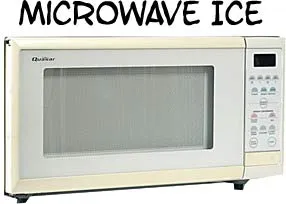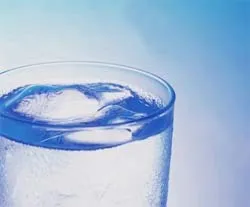 The Teacher's Corner
The Teacher's Corner
Microwave Ice Science Experiment
This week's experiment is a result of defrosting some frozen food. Have you ever wondered why there is a defrost setting on your microwave? Why can't you just use the regular setting?
 To find out, you will need:
To find out, you will need:
- 2 glasses
- water
- ice cubes
- a microwave oven
Fill one glass about half full of water. Fill the other about half full of ice cubes. Work quickly, as you don't want any of the ice to melt before you start. Put both into the microwave oven and cook both at full power for one minute. Carefully, because things may be very hot, remove both glasses from the oven. You will find that the water is quite hot, but the ice will not have melted at all. Why?
Your microwave oven works by directing microwave radiation at your food. Radiation! Is my food going to glow in the dark? No, here radiation means radiant energy, which includes visible light, radio signals, microwaves, and the rest of the electromagnetic spectrum.
As we have seen in the past, water molecules are polar. One end of the molecule has a positive charge, and the other end has a negative charge. The water molecules rotate to align with the alternating electric field produced by the microwaves. As they rotate quickly back and forth, the water gets hot.
 With the ice, the water molecules are locked into position. Since they can't rotate back and forth, they do not convert the microwaves into heat. Then how can the microwave oven defrost food? Put a fresh glass of water into the oven and set it on the defrost setting. Cook the water for 30 seconds, paying attention to what the oven is doing. You should hear the sound changing as the oven cycles on and off.
With the ice, the water molecules are locked into position. Since they can't rotate back and forth, they do not convert the microwaves into heat. Then how can the microwave oven defrost food? Put a fresh glass of water into the oven and set it on the defrost setting. Cook the water for 30 seconds, paying attention to what the oven is doing. You should hear the sound changing as the oven cycles on and off.
On the surface of the frozen food, some of the ice will begin to melt at room temperature. The microwaves will cause this tiny bit of water to get hot. Then the oven's defrost setting turns the power off for a few seconds, giving that heat time to be absorbed into the surrounding food. That heat melts a bit more of the ice, so when the oven cycles back on, there will be more water available to heat. Then the oven cycles off again, and the heat is again absorbed by the surrounding ice.
If the oven did not cycle on and off, all the heat would be concentrated in the food near the liquid water. That part would burn before the rest of the food began to thaw.
The same is true for the other power settings of most microwave ovens. Setting the power at 50% does not turn down the amount off microwave radiation. Instead, the oven cycles on and off to give you about 50% of the heating that you would get if it were on continuously.
Have a wonder filled week!
 Check out more easy and fun science experiments
Check out more easy and fun science experiments
All lessons are brought to you by The Teacher's Corner and Robert Krampf's Science Education Company.
Robert Krampf's Science Shows thehappyscientist.com